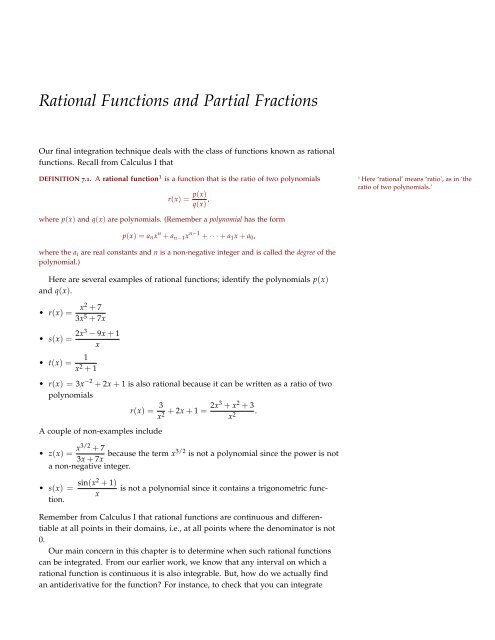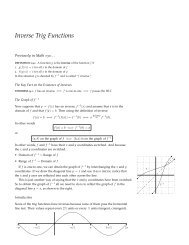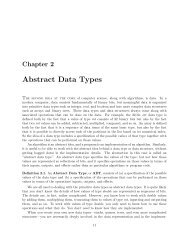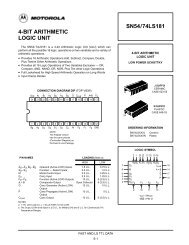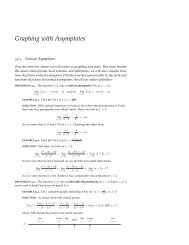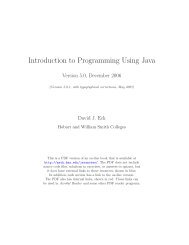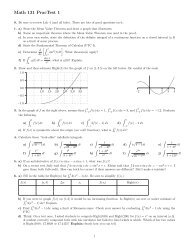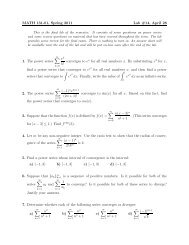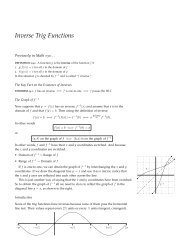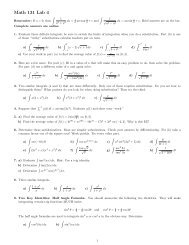Class Notes Day 26 on Partial Fractions
Class Notes Day 26 on Partial Fractions
Class Notes Day 26 on Partial Fractions
You also want an ePaper? Increase the reach of your titles
YUMPU automatically turns print PDFs into web optimized ePapers that Google loves.
Rati<strong>on</strong>al Functi<strong>on</strong>s and <strong>Partial</strong> Fracti<strong>on</strong>s<br />
Our final integrati<strong>on</strong> technique deals with the class of functi<strong>on</strong>s known as rati<strong>on</strong>al<br />
functi<strong>on</strong>s. Recall from Calculus I that<br />
DEFINITION 7.1. A rati<strong>on</strong>al functi<strong>on</strong> 1 is a functi<strong>on</strong> that is the ratio of two polynomials<br />
r(x) = p(x)<br />
q(x) ,<br />
1<br />
Here ‘rati<strong>on</strong>al’ means ‘ratio’, as in ‘the<br />
ratio of two polynomials.’<br />
where p(x) and q(x) are polynomials. (Remember a polynomial has the form<br />
p(x) = a n x n + a n−1 x n−1 + · · · + a 1 x + a 0 ,<br />
where the a i are real c<strong>on</strong>stants and n is a n<strong>on</strong>-negative integer and is called the degree of the<br />
polynomial.)<br />
Here are several examples of rati<strong>on</strong>al functi<strong>on</strong>s; identify the polynomials p(x)<br />
and q(x).<br />
• r(x) = x2 + 7<br />
3x 5 + 7x<br />
• s(x) = 2x3 − 9x + 1<br />
x<br />
• t(x) = 1<br />
x 2 + 1<br />
• r(x) = 3x −2 + 2x + 1 is also rati<strong>on</strong>al because it can be written as a ratio of two<br />
polynomials<br />
r(x) = 3 x 2 + 2x + 1 = 2x3 + x 2 + 3<br />
x 2 .<br />
A couple of n<strong>on</strong>-examples include<br />
• z(x) = x3/2 + 7<br />
3x + 7x because the term x3/2 is not a polynomial since the power is not<br />
a n<strong>on</strong>-negative integer.<br />
is not a polynomial since it c<strong>on</strong>tains a trig<strong>on</strong>ometric func-<br />
• s(x) = sin(x2 + 1)<br />
x<br />
ti<strong>on</strong>.<br />
Remember from Calculus I that rati<strong>on</strong>al functi<strong>on</strong>s are c<strong>on</strong>tinuous and differentiable<br />
at all points in their domains, i.e., at all points where the denominator is not<br />
0.<br />
Our main c<strong>on</strong>cern in this chapter is to determine when such rati<strong>on</strong>al functi<strong>on</strong>s<br />
can be integrated. From our earlier work, we know that any interval <strong>on</strong> which a<br />
rati<strong>on</strong>al functi<strong>on</strong> is c<strong>on</strong>tinuous it is also integrable. But, how do we actually find<br />
an antiderivative for the functi<strong>on</strong>? For instance, to check that you can integrate
math 131, techniques of integrati<strong>on</strong> v partial fracti<strong>on</strong>s 2<br />
∫<br />
∫<br />
∫<br />
1<br />
1 + x 2 dx, x 3x 2 ∫<br />
1 + x 2 dx, − 1<br />
x 3 − x dx, and 1<br />
dx. But what about very similar<br />
looking functi<strong>on</strong>s such as<br />
∫ ∫ 1 + x<br />
2x + 1<br />
x 3 − x dx or 4<br />
dx? Why are these integrals<br />
4 − x2 not so easy to do? Over the next few secti<strong>on</strong>s, we examine a series of special cases<br />
of rati<strong>on</strong>al functi<strong>on</strong>s that we will see are relatively easy to integrate using a technique<br />
known as partial fracti<strong>on</strong>s.<br />
7.1 Special Cases: Linear Factors with Degree p(x) < q(x)<br />
There are several techniques that can be used integrate rati<strong>on</strong>al functi<strong>on</strong>s. We will<br />
c<strong>on</strong>centrate <strong>on</strong> a single technique and a couple of simple variati<strong>on</strong>s that work with<br />
rati<strong>on</strong>al functi<strong>on</strong>s of a particular type.<br />
Assume we have a rati<strong>on</strong>al functi<strong>on</strong> of the form<br />
r(x) = p(x)<br />
q(x) ,<br />
where degree of p(x) < degree of q(x) and q(x) can be factored into linear factors<br />
(factors of degree 1). Some examples include<br />
• 2x + 1<br />
x 3 − x = 2x + 1<br />
x(x 2 − 1) = 2x + 1<br />
where all the factors in the denominator<br />
x(x − 1)(x + 1)<br />
are linear and different and degree p(x) = 1 and degree q(x) = 3.<br />
4<br />
•<br />
4 − x 2 = 4<br />
; the two factors in the denominator are linear and<br />
(2 − x)(2 + x)<br />
different and degree of p(x) < degree of q(x).<br />
6x − 2<br />
•<br />
x 2 − 2x − 3 = 6x − 2<br />
where all the factors in the denominator are linear<br />
(x − 3)(x + 1)<br />
and different and degree of p(x) < degree of q(x).<br />
• x + 4<br />
x 3 + x 2 = x + 4<br />
; the three factors in the denominator are linear and<br />
x · x(x + 1)<br />
degree of p(x) < degree of q(x).<br />
On the other hand the rati<strong>on</strong>al functi<strong>on</strong><br />
2x + 1<br />
x 3 + x = 2x + 1<br />
x(x 2 + 1)<br />
does not satisfy our criteri<strong>on</strong> above because the denominator c<strong>on</strong>tains a factor of<br />
degree 2, in particular, x 2 + 1 cannot be written as a product of linear factors.<br />
We will use a technique called partial fracti<strong>on</strong>s to integrate the special rati<strong>on</strong>al<br />
functi<strong>on</strong>s above. 2<br />
The Key to <strong>Partial</strong> Fracti<strong>on</strong>s<br />
2 <strong>Partial</strong> fracti<strong>on</strong>s can be used to integrate<br />
other types of rati<strong>on</strong>al functi<strong>on</strong>s.<br />
Your text has further examples.<br />
Let’s look at a couple of ordinary fracti<strong>on</strong>s and how they can be rewritten in ‘simpler’<br />
terms. Notice<br />
1<br />
20 = 1 4 − 1 5<br />
or<br />
10<br />
21 = 1 3 + 1 7 .
math 131, techniques of integrati<strong>on</strong> v partial fracti<strong>on</strong>s 3<br />
In each case the original fracti<strong>on</strong> has been rewritten in terms of simpler comp<strong>on</strong>ent<br />
fracti<strong>on</strong>s. The idea is to do the same for rati<strong>on</strong>al functi<strong>on</strong>s. For example, can we<br />
write<br />
4<br />
4 − x 2 as<br />
A<br />
2 − x + B<br />
2 + x<br />
where 2 − x and 2 + x are the linear factors of 4 − x 2 ? If we could, then putting the<br />
two simpler pieces back over a comm<strong>on</strong> denominator would give us<br />
4<br />
4 − x 2 = A<br />
2 − x + B 2A + Ax + 2B − Bx (A − B)x + (2A + 2B)<br />
=<br />
2 + x 4 − x 2 =<br />
4 − x 2 . (7.1)<br />
The first and last rati<strong>on</strong>al functi<strong>on</strong>s in (7.1) are equal and have the same denominator.<br />
The <strong>on</strong>ly way that this can happen is if the numerators are also the same. So<br />
(7.1) means<br />
4 = (A − B)x + (2A + 2B). (7.2)<br />
But (7.2) is true if and <strong>on</strong>ly if the x-terms <strong>on</strong> each side are equal and the c<strong>on</strong>stants<br />
<strong>on</strong> each side are equal. Since there are no x’s <strong>on</strong> the left side and A − B <strong>on</strong> the<br />
right, we must have<br />
x’s : 0 = A − B. (7.3)<br />
Comparing the c<strong>on</strong>stant terms in the same way we have<br />
c<strong>on</strong>stants : 4 = 2A + 2B. (7.4)<br />
From (7.3) we see that A = B and using this in (7.4) gives<br />
4 = 4A.<br />
Thus, A = 1. Putting A = 1 in (7.3) or (7.4) makes B = 1. So we see that<br />
4<br />
4 − x 2 = 1<br />
2 − x + 1<br />
2 + x . (7.5)<br />
Check that this is correct! We describe this process by saying that we have rewritten<br />
4 1<br />
as<br />
4−x 2 2−x + 2+x 1 using partial fracti<strong>on</strong>s.<br />
∫<br />
4<br />
So what! How do we use this? Well, suppose we need to solve<br />
4 − x 2 dx.<br />
Using (7.5) we can rewrite it and then integrate (using a ‘mental adjustment’):<br />
∫<br />
∫ (<br />
4<br />
1<br />
4 − x 2 dx = 2 − x + 1 )<br />
dx<br />
2 + x<br />
= − ln |2 − x| + ln |2 + x| + c = ln<br />
2 − x<br />
∣ 2 + x ∣ + c.<br />
7.2 The Easiest Case: Distinct Linear Factors<br />
We can always carry out the same sort of process as above under the following<br />
circumstances: 3<br />
The Easiest Case: Let r(x) = r(x) be a rati<strong>on</strong>al functi<strong>on</strong>. Assume that the denominator<br />
q(x)<br />
q(x) of the rati<strong>on</strong>al functi<strong>on</strong> factors into distinct linear and the degree of the numerator<br />
p(x) is less than the degree of the denominator q(x). Then r(x) = p(x) can be<br />
q(x)<br />
rewritten using partial fracti<strong>on</strong>s.<br />
3 This is not so easy to prove in general;<br />
usually <strong>on</strong>e sees the proof of this result<br />
in a graduate-level abstract algebra<br />
course.
math 131, techniques of integrati<strong>on</strong> v partial fracti<strong>on</strong>s 4<br />
EXAMPLE 7.2.1 (<strong>Partial</strong> Fracti<strong>on</strong>s: Easiest Case). Here’s another example that uses partial fracti<strong>on</strong>s.<br />
Determine<br />
∫<br />
3<br />
x 2 + 3x + 2 dx.<br />
SOLUTION. This is not an integral that we can immediately do, even with integrati<strong>on</strong><br />
by parts. 4 So we try partial fracti<strong>on</strong>s. Notice that the degree of the numerator is less<br />
than the degree of the denominator (0 < 2) and the denominator factors into distinct<br />
A<br />
linear factors: (x + 1)(x + 2). We form the partial fracti<strong>on</strong>s x+1 and x+2 B , where A and<br />
B are c<strong>on</strong>stants. We solve for A and B as we did in the previous example.<br />
3<br />
x 2 + 3x + 2 = 3<br />
(x + 1)(x + 2) = A<br />
x + 1 + B<br />
x + 2 .<br />
By putting the last terms together again, we get<br />
3 Ax + 2A + Bx + B<br />
x 2 =<br />
+ 3x + 2 x 2 =<br />
+ 3x + 2<br />
(A + B)x + (2A + B)<br />
x 2 .<br />
+ 3x + 2<br />
Since the denominators are the same, the numerators must be the same, too. In particular<br />
there are as many x’s <strong>on</strong> the left side as <strong>on</strong> the right. There are n<strong>on</strong>e <strong>on</strong> the left<br />
and A + B <strong>on</strong> the right side. Similarly for the c<strong>on</strong>stants.<br />
4<br />
D<strong>on</strong>’t c<strong>on</strong>fuse the terms partial fracti<strong>on</strong>s<br />
with integrati<strong>on</strong> by parts.<br />
x’s: 0 = A + B<br />
c<strong>on</strong>stants: 3 = 2A + B<br />
Subtracting the first equati<strong>on</strong> from the sec<strong>on</strong>d gives<br />
3 = A.<br />
Substituting A = 3 into first or sec<strong>on</strong>d equati<strong>on</strong> makes B = −3. So we see that<br />
3<br />
x 2 + 3x + 2 = 3<br />
x + 1 − 3<br />
x + 2 .<br />
Now <strong>on</strong> to integrati<strong>on</strong>:<br />
∫<br />
∫ (<br />
3<br />
3<br />
x 2 + 3x + 2 dx = x + 1 − 3 )<br />
dx<br />
x + 2<br />
= 3 ln |x + 1| − 3 ln |x + 2| + c = 3 ln<br />
x + 1<br />
∣ x + 2 ∣ + c.<br />
EXAMPLE 7.2.2 (<strong>Partial</strong> Fracti<strong>on</strong>s: Easiest Case). Determine<br />
∫<br />
6x − 2<br />
x 2 − 2x − 3 dx.<br />
SOLUTION. This is not an integral that we can immediately do with substituti<strong>on</strong> or<br />
integrati<strong>on</strong> by parts. So we try partial fracti<strong>on</strong>s. The degree of the numerator is less<br />
than the degree of the denominator (1 < 2) and the denominator factors into distinct<br />
linear factors: (x − 3)(x + 1). We form the partial fracti<strong>on</strong>s<br />
B are c<strong>on</strong>stants.<br />
6x − 2<br />
x 2 − 2x − 3 = 6x − 2<br />
(x − 3)(x + 1) = A<br />
x − 3 +<br />
B<br />
x + 1<br />
So comparing the numerators of the first and last functi<strong>on</strong>s<br />
x’s: 6 = A + B<br />
c<strong>on</strong>stants: −2 = A − 3B<br />
Subtracting the sec<strong>on</strong>d equati<strong>on</strong> from the first gives<br />
8 = 4B.<br />
A<br />
x−3 and<br />
B<br />
x+1<br />
Ax + A + Bx − 3B<br />
=<br />
x 2 .<br />
− 2x − 3<br />
, where A and<br />
So B = 2. Using this in the first or sec<strong>on</strong>d equati<strong>on</strong> makes A = 4. Now <strong>on</strong> to integrati<strong>on</strong><br />
(using an adjustment):<br />
∫<br />
∫ (<br />
6x − 2<br />
4<br />
x 2 − 2x − 3 dx = x − 3 + 2 )<br />
dx = 4 ln |x − 3| + 2 ln |x + 1| + c.<br />
x + 1
math 131, techniques of integrati<strong>on</strong> v partial fracti<strong>on</strong>s 5<br />
YOU TRY IT 7.1. Does it matter which letters you put over each linear factor? What would<br />
the numerator in the original integral have to be to make the problem a substituti<strong>on</strong> problem?<br />
EXAMPLE 7.2.3 (<strong>Partial</strong> Fracti<strong>on</strong>s: Easiest Case). Here’s another quick example. Determine<br />
∫<br />
2x + 5<br />
x 2 + 2x − 8 dx.<br />
SOLUTION. Notice this is not quite a substituti<strong>on</strong> integral, but partial fracti<strong>on</strong>s will<br />
work. The degree of the numerator is less than the degree of the denominator (1 < 2)<br />
and the denominator factors into distinct linear factors: (x − 2)(x + 4).<br />
2x + 5<br />
x 2 + 2x − 8 = 2x + 5<br />
(x − 2)(x + 4) = A<br />
x − 2 +<br />
B<br />
x + 4<br />
Ax + 4A + Bx − 2B<br />
=<br />
x 2 .<br />
+ 2x − 8<br />
Comparing the numerators of the first and last functi<strong>on</strong>s and solving for A and B<br />
gives<br />
x’s: 2 = A + B ⇒ 4 = 2A + 2B<br />
c<strong>on</strong>stants: 5 = 4A − 2B 5 = 4A − 2B<br />
Answers to you try it 7.1 : No. It<br />
would have to be a multiple of 2x − 2.<br />
9 = 6A<br />
So A = 3 2 and B = 1 2 . The integrati<strong>on</strong> becomes:<br />
∫<br />
∫<br />
2x + ( )<br />
3 1<br />
5<br />
x 2 + 2x − 8 dx = 2<br />
x − 2 + 2 dx = 3 x + 4 2 ln |x − 2| + 2 1 ln |x + 4| + c.<br />
YOU TRY IT 7.2. What would the numerator in the original integral have to be to make the<br />
problem a substituti<strong>on</strong> problem?<br />
7.3 A Complicati<strong>on</strong>: Higher Degrees<br />
The first complicati<strong>on</strong> that arises is is that the denominator of the rati<strong>on</strong>al functi<strong>on</strong><br />
may factor into three or more distinct linear factors. The soluti<strong>on</strong> method works<br />
the same way as above, but it may be more complicated to find the c<strong>on</strong>stants.<br />
EXAMPLE 7.3.1 (<strong>Partial</strong> Fracti<strong>on</strong>s: Three Distinct Linear Factors). Determine<br />
∫ 2x 2 − 6x + 2<br />
x 3 − 3x 2 + 2x dx.<br />
SOLUTION. Check that this is not quite a substituti<strong>on</strong> integral. However, the degree<br />
of the numerator is less than the degree of the denominator (2 < 3) and the denominator<br />
factors into distinct three linear factors: x(x 2 − 3x + 2) = x(x − 1)(x − 2). We<br />
form the partial fracti<strong>on</strong>s with a different c<strong>on</strong>stant for each linear factor:<br />
2x 2 − 6x + 2<br />
x 3 − 3x 2 + 2x = 2x2 − 6x + 2<br />
x(x − 1)(x − 2) = A x +<br />
B<br />
x − 1 +<br />
C<br />
x − 2<br />
A(x − 1)(x − 2) + Bx(x − 2) + Cx(x − 1)<br />
=<br />
x 3 − 3x 2 + 2x<br />
= Ax2 − 3Ax + 2A + Bx 2 − 2B + Cx 2 − Cx<br />
x 3 − 3x 2 .<br />
+ 2x<br />
Compare like terms in the numerators of the first and last functi<strong>on</strong>s.<br />
x 2 ’s: 2 = A + B + C ⇒ 1 = B + C<br />
x’s: −6 = −3A − 2B − C ⇒ −3 = −2B − C<br />
c<strong>on</strong>st: 2 = 2A ⇒ A = 1 −2 = −B<br />
Notice that we used the value A = 1 to simplify the first two equati<strong>on</strong>s. It follows that<br />
B = 2 and C = −1. The integrati<strong>on</strong> becomes:<br />
∫ 2x 2 ∫<br />
− 6x + 2 1<br />
x 3 − 3x 2 + 2x dx = x + 2<br />
x − 1 − 1 dx = ln |x| + 2 ln |x − 1| − ln |x − 2| + c.<br />
x − 2
math 131, techniques of integrati<strong>on</strong> v partial fracti<strong>on</strong>s 6<br />
YOU TRY IT 7.3. What would the numerator in the original integral have to be to make the<br />
problem a substituti<strong>on</strong> problem?<br />
EXAMPLE 7.3.2 (<strong>Partial</strong> Fracti<strong>on</strong>s: Three Distinct Linear Factors). Determine<br />
∫ x 2 + 4x − 1<br />
x 3 dx.<br />
− x<br />
SOLUTION. Check that this is not a substituti<strong>on</strong> integral. However, the degree of the<br />
numerator is less than the degree of the denominator (2 < 3) and the denominator<br />
factors into distinct three linear factors: x(x 2 − 1) = x(x − 1)(x + 1). We form the<br />
partial fracti<strong>on</strong>s with a different c<strong>on</strong>stant for each linear factor:<br />
x 2 + 4x − 1<br />
x 3 − x<br />
= A x + B<br />
x − 1 + C<br />
x + 1 = A(x2 − 1) + Bx(x + 1) + Cx(x − 1)<br />
x 3 − x<br />
= Ax2 − A + Bx 2 + B + Cx 2 − Cx<br />
x 3 .<br />
− x<br />
Compare like terms in the numerators of the first and last functi<strong>on</strong>s.<br />
x 2 ’s: 1 = A + B + C ⇒ 0 = B + C<br />
x’s: 4 = B − C ⇒ 4 = B − C<br />
c<strong>on</strong>st: −1 = −A ⇒ A = 1 4 = 2B<br />
Notice that we used the value A = 1 to simplify the first two equati<strong>on</strong>s. It follows that<br />
B = 2 and C = −2. The integrati<strong>on</strong> becomes:<br />
∫ x 2 + 4x − 1<br />
x 3 dx =<br />
− x<br />
∫ 1<br />
x + 2<br />
x − 1 − 2<br />
x + 1<br />
dx = ln |x| + 2 ln |x − 1| − 2 ln |x + 1| + c<br />
= ln |x| + 2 ln<br />
x − 1<br />
∣ x + 1 ∣ + c.<br />
EXAMPLE 7.3.3 (<strong>Partial</strong> Fracti<strong>on</strong>s: Three Distinct Linear Factors). Determine<br />
∫<br />
4x + 28<br />
(x + 1)(x 2 − 4x + 3) dx.<br />
SOLUTION. Check that this is not a substituti<strong>on</strong> integral. However, the degree of the<br />
numerator is less than the degree of the denominator (1 < 3) and the denominator<br />
factors into distinct three linear factors: (x + 1)(x 2 − 4x + 3) = (x + 1)(x − 1)(x − 3).<br />
We form the partial fracti<strong>on</strong>s with a different c<strong>on</strong>stant for each linear factor:<br />
4x + 28<br />
(x + 1)(x 2 − 4x + 3) = A<br />
x + 1 +<br />
B<br />
x − 1 +<br />
C<br />
x − 3 = A(x2 − 4x + 3) + B(x 2 − 2x − 3) + C(x 2 − 1)<br />
(x + 1)(x 2 − 4x + 3)<br />
= (A + B + C)x2 + (−4A − 2B)x + 3A − 3B − C<br />
(x + 1)(x 2 .<br />
− 4x + 3)<br />
Compare like terms in the numerators of the first and last functi<strong>on</strong>s.<br />
x 2 ’s: 0 = A + B + C ⇒ C = 5<br />
x’s: 4 = −4A − 2B ⇒ A = 3<br />
c<strong>on</strong>st: 28 = 3A − 3B − C<br />
Add all: 32 = − 4B ⇒ B = −8<br />
The integrati<strong>on</strong> becomes:<br />
∫<br />
∫<br />
4x + 28<br />
(x + 1)(x 2 − 4x + 3) dx =<br />
3<br />
x + 1 − 8<br />
x − 1 + 5<br />
x − 3 dx<br />
= 3 ln |x − 1| − 8 ln |x + 1| + 5 ln |x − 3| + c<br />
YOU TRY IT 7.4. What would the numerator in the original integral have to be to make the<br />
problem a substituti<strong>on</strong> problem?
math 131, techniques of integrati<strong>on</strong> v partial fracti<strong>on</strong>s 7<br />
7.4 A Sec<strong>on</strong>d Complicati<strong>on</strong>: Repeated Factors<br />
Another complicati<strong>on</strong> that can arise is that the denominator of the rati<strong>on</strong>al functi<strong>on</strong><br />
factors into linear factors, but the factors are not distinct. That is, there are<br />
repeated linear factors. The soluti<strong>on</strong> in this situati<strong>on</strong> is to include a term for every<br />
power of every linear factor that divides the denominator.<br />
EXAMPLE 7.4.1 (<strong>Partial</strong> Fracti<strong>on</strong>s: Repeated Linear Factors). Determine<br />
∫ 3x 2 − 7x + 2<br />
x 3 − 2x 2 + x dx.<br />
SOLUTION. This is not a substituti<strong>on</strong> integral. However, the degree of the numerator<br />
is less than the degree of the denominator (2 < 3) and the denominator factors into<br />
repeated linear factors:<br />
x(x 2 − 2x + 1) = x(x − 1)(x − 1) = x(x − 1) 2 .<br />
We form the partial fracti<strong>on</strong>s with a different c<strong>on</strong>stant for each power of each factor<br />
that divides the denominator. Note: There are terms for both x − 1 and (x − 1) 2 .<br />
Warning! Look very carefully at the numerator in the step where the comm<strong>on</strong> denominator<br />
is formed.<br />
3x 2 − 7x + 2<br />
x(x − 1) 2 = A x + B<br />
x − 1 + C<br />
(x − 1) 2 = A(x − 1)2 + Bx(x − 1) + Cx<br />
x(x − 1) 2<br />
= Ax2 − 2Ax + A + Bx 2 − Bx + Cx<br />
x(x − 1) 2 .<br />
Compare like terms in the numerators of the first and last functi<strong>on</strong>s.<br />
x 2 ’s: 3 = A + B ⇒ 1 = B<br />
x’s: −7 = −2A − B + C ⇒ C = −2<br />
c<strong>on</strong>st: 2 = A ⇒ A = 2<br />
Notice that we used the value A = 2 to simplify the first two equati<strong>on</strong>s. The integrati<strong>on</strong><br />
becomes:<br />
∫ 3x 2 − 7x + 2<br />
x 3 − 2x 2 + x dx = ∫ 2<br />
x + 1<br />
x − 1 − 2<br />
(x − 1) 2 dx<br />
= 2 ln |x| + ln |x − 1| + 2(x − 1) −1 + c.<br />
Be careful! The final integral requires the power rule and a mini-substituti<strong>on</strong>.<br />
YOU TRY IT 7.5. What would the numerator in the original integral have to be to make the<br />
problem a substituti<strong>on</strong> problem?<br />
EXAMPLE 7.4.2 (<strong>Partial</strong> Fracti<strong>on</strong>s: Repeated Linear Factors). Determine<br />
∫ 3x 2 − 2x − 3<br />
x 3 − x 2<br />
SOLUTION. This is not quite a substituti<strong>on</strong> integral. However, the degree of the numerator<br />
is less than the degree of the denominator (2 < 3) and the denominator<br />
factors into repeated linear factors: x 2 (x − 1). We form the partial fracti<strong>on</strong>s with a<br />
different c<strong>on</strong>stant for each power of each factor that divides the denominator—there<br />
are terms for both x and x 2 . Look very carefully at the numerator in the step where<br />
the comm<strong>on</strong> denominator is formed.<br />
3x 2 − 2x − 3<br />
x 2 (x − 1)<br />
dx.<br />
= A x + B x 2 + C Ax(x − 1) + B(x − 1) + Cx2<br />
=<br />
x − 1 x 2 (x − 1)<br />
= Ax2 − Ax + Bx − B + Cx 2<br />
x 2 .<br />
(x − 1)
math 131, techniques of integrati<strong>on</strong> v partial fracti<strong>on</strong>s 8<br />
Compare like terms in the numerators of the first and last functi<strong>on</strong>s.<br />
x 2 ’s: 3 = A + C ⇒ C = −2<br />
x’s: −2 = −A + B ⇒ A = 5<br />
c<strong>on</strong>st: −3 = −B ⇒ B = 3<br />
Notice that we used the value B = 3 to simplify the first two equati<strong>on</strong>s. The integrati<strong>on</strong><br />
becomes:<br />
∫ 3x 2 ∫<br />
− 2x − 3 5<br />
x 3 − x 2 dx =<br />
x + 3 x 2 − 2<br />
x − 1 dx = 5 ln |x| − 3x−1 − 2 ln |x − 1| + c.<br />
YOU TRY IT 7.6. What would the numerator in the original integral have to be to make the<br />
problem a substituti<strong>on</strong> problem?<br />
YOU TRY IT 7.7. Determine<br />
∫<br />
7 − x<br />
(x + 1)(x − 1) 2 dx.<br />
Answer to you try it 7.7 : 2 ln |x + 1| −<br />
2 ln |x − 1| − 3<br />
x−1 .<br />
EXAMPLE 7.4.3 (<strong>Partial</strong> Fracti<strong>on</strong>s: Repeated Linear Factors). Here’s a different <strong>on</strong>e: Determine<br />
∫<br />
x 2<br />
(x + 1) 3 dx.<br />
SOLUTION. The degree of the numerator is less than the degree of the denominator<br />
(2 < 3) and the denominator factors into repeated linear factors: (x + 1) 3 = (x +<br />
1)(x + 1)(x + 1). We form the partial fracti<strong>on</strong>s with a different c<strong>on</strong>stant for each<br />
power of each factor that divides the denominator: (x + 1), (x + 1) 2 , and (x + 1) 3 .<br />
Look very carefully at the numerator in the step where the comm<strong>on</strong> denominator is<br />
formed.<br />
x 2<br />
(x + 1) 3 = A<br />
x + 1 + B<br />
(x + 1) 2 + C<br />
(x + 1) 3 = A(x + 1)2 + B(x + 1) + C<br />
(x + 1) 3<br />
= Ax2 + 2Ax + A + Bx + B + C<br />
(x + 1) 3 .<br />
Compare like terms in the numerators of the first and last functi<strong>on</strong>s.<br />
x 2 ’s: 1 = A ⇒ A = 1<br />
x’s: 0 = 2A + B ⇒ B = −2<br />
c<strong>on</strong>st: 0 = A + B + C ⇒ C = 1<br />
Notice that we used the value A = 1 to simplify the last two equati<strong>on</strong>s. The integrati<strong>on</strong><br />
becomes:<br />
∫<br />
x 2 ∫<br />
(x + 1) 3 dx =<br />
1<br />
x + 1 − 2<br />
(x + 1) 2 + 1<br />
(x + 1) 3 dx<br />
= ln |x + 1| + 2(x + 1) −1 − 1 2 (x + 1)−2 + c.<br />
Alternative Soluti<strong>on</strong>. We could have used a u-substituti<strong>on</strong> to solve this problem. Let<br />
u = x + 1. Then du = dx. Since u = x + 1, then x = u − 1 so x 2 = (u − 1) 2 =<br />
u 2 − 2u + 1. Therefore<br />
∫<br />
x 2 ∫ u<br />
(x + 1) 3 dx = 2 ∫<br />
− 2u + 1<br />
u 3 du =<br />
1<br />
u − 2 u 2 + 1 u 3 du<br />
= ln |u| − 2u −1 − 1 2 u−2 + c<br />
= ln |x + 1| + 2(x + 1) −1 − 1 2 (x + 1)−2 + c,<br />
just as above. Which method would you have used? Why?<br />
7.5 Problems
math 131, techniques of integrati<strong>on</strong> v partial fracti<strong>on</strong>s 9<br />
1. Try integrating these rati<strong>on</strong>al functi<strong>on</strong>s (answers below). These are a bit harder than<br />
those in the text. Some have three factors. Others have repeated factors.<br />
∫ 4t 2 − 3t − 4<br />
(a)<br />
t 3 − t 2 − 2t dt<br />
∫<br />
(d)<br />
(g)<br />
∫<br />
(b) ∫<br />
∫<br />
x<br />
(x − 1)(x + 1)(x + 2) dx (e)<br />
∫<br />
2x<br />
(x − 2)(x 2 − 1) dx (h)<br />
2. Try these similar looking problems.<br />
(a)<br />
∫<br />
∫<br />
10<br />
25 + x 2 dx (b)<br />
∫<br />
10x<br />
25 + x 2 dx (c)<br />
∫<br />
t + 7<br />
(t + 1)(t 2 − 4t + 3) dt (c)<br />
x + 6<br />
x 2 − x − 6 dx<br />
2x 2<br />
∫ −4x + 4<br />
(x − 1) 2 (x + 1) dx (f ) (x − 2) 2 x dx<br />
2x − 1<br />
(x + 2) 2 dx<br />
10<br />
25 − x 2 dx<br />
3. Have you finished all the <strong>on</strong>es above? Do these similar looking integrals.<br />
(a)<br />
(c)<br />
∫<br />
∫<br />
4<br />
√<br />
4 + x 2 dx<br />
(b) ∫<br />
∫<br />
4x<br />
2<br />
(4 + x 2 ) 3/2 dx (d)<br />
4<br />
√<br />
4 − x 2 dx<br />
−2<br />
√<br />
4 − x 2 dx<br />
Answers to Practice Problems<br />
1. (a) ∫ 2<br />
t<br />
+<br />
t−2 1 + t+1 1 dt = 2 ln |t| + ln |t − 2| + ln |t + 1| + c<br />
(b) ∫ 3/4<br />
t+1 + t−3 5/4 − t−1 2 dt = 4 3 ln |t + 1| + 5 4<br />
ln |t − 3| − 2 ln |t − 1| + c<br />
(c) ∫ 9/5<br />
x−3 − x+2 4/5 dt = x + 9 5 ln |x − 3| − 4 5<br />
ln |x + 2| + c<br />
(d) ∫ 1/6<br />
x−1 + x+1 1/2 − x+2 2/3 dx = 1 6 ln |x − 1| + 1 2 ln |x + 1| − 3 2 ln |x + 2| + c<br />
(e) ∫ 3/2<br />
x−1 + 1 + 1/2<br />
(x−1) 2 x+1 dx = 3 2 ln |x − 1| − (x − 1)−1 +<br />
2 1 ln |x + 1| + c<br />
(f ) ∫ − 1<br />
x−2 − 2<br />
(x−2) 2 + 1 x dx = − ln |x − 2| + 2(x − 2)−1 + ln |x| + c<br />
(g) ∫ 2<br />
x+2 − 5<br />
(x+2) 2 dx = 2 ln |x + 2| + 5<br />
x+2 + c.<br />
2. All “+c".<br />
(a) 2 arctan(x/5) (b) 5 ln |25 + x 2 | (c) ln<br />
x + 5<br />
∣ x − 5 ∣


